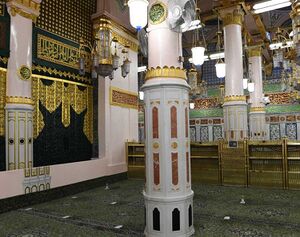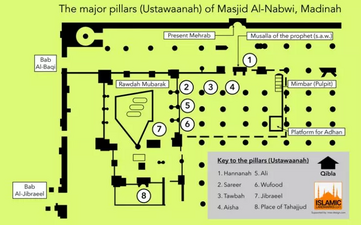Al-Tawba Pillar: Difference between revisions
m Engineer moved page Al-Tawba pillar to Al-Tawba Pillar |
m Text replacement - "<gallery>" to "<gallery mode="packed" heights="150px">" |
||
| (3 intermediate revisions by the same user not shown) | |||
| Line 70: | Line 70: | ||
According to hadiths, it is recommended for pilgrims of [[Medina]] to stay in this city from Wednesday to Friday and fast and perform their prayers near Al-Tawba pillar on Wednesday.<ref>Kulaynī, ''al-Kāfī'', vol. 4, p. 558; Ḥillī, ''Kitāb al-sarāʾir'', vol. 1, p. 652.</ref> It is also recommended to say prayers,<ref>Ibn al-Mashhadī, ''al-Mazār'', p. 65.</ref> pray<ref>Ṣadūq, ''Man lā yaḥḍuruh al-faqīh'', vol. 2, p. 572.</ref> and seek blessings from this pillar.<ref>Amīnī, ''al-Ghadīr'', vol. 5, p. 124; Subḥānī, ''al-Zīyāra fī l-kitāb wa al-sunna'', p. 40.</ref> | According to hadiths, it is recommended for pilgrims of [[Medina]] to stay in this city from Wednesday to Friday and fast and perform their prayers near Al-Tawba pillar on Wednesday.<ref>Kulaynī, ''al-Kāfī'', vol. 4, p. 558; Ḥillī, ''Kitāb al-sarāʾir'', vol. 1, p. 652.</ref> It is also recommended to say prayers,<ref>Ibn al-Mashhadī, ''al-Mazār'', p. 65.</ref> pray<ref>Ṣadūq, ''Man lā yaḥḍuruh al-faqīh'', vol. 2, p. 572.</ref> and seek blessings from this pillar.<ref>Amīnī, ''al-Ghadīr'', vol. 5, p. 124; Subḥānī, ''al-Zīyāra fī l-kitāb wa al-sunna'', p. 40.</ref> | ||
==Gallary== | ==Gallary== | ||
<gallery> | <gallery mode="packed" heights="150px"> | ||
file:نقشه مسجدالنبی و ستونهای آن.webp|The map of [[Masjid al-Nabi]] where number 3 shows the location of the al-Tawba pillar. | file:نقشه مسجدالنبی و ستونهای آن.webp|The map of [[Masjid al-Nabi]] where number 3 shows the location of the al-Tawba pillar. | ||
file:ستون توبه۴.png|A view of the al-Tawba pillar from [[the prophet's pulpit]] (the al-Tawba pillar is the fourth pillar after the prophet's pulpit). | file:ستون توبه۴.png|A view of the al-Tawba pillar from [[the prophet's pulpit]] (the al-Tawba pillar is the fourth pillar after the prophet's pulpit). | ||
| Line 98: | Line 98: | ||
*Ṭūsī, Muḥammad b. al-Ḥasan al-. ''Al-Nihāya fī mujarrad al-fiqh wa l-fatāwā''. Beirut: Dār al-Kutub al-ʿArabiyya, 1400 AH. | *Ṭūsī, Muḥammad b. al-Ḥasan al-. ''Al-Nihāya fī mujarrad al-fiqh wa l-fatāwā''. Beirut: Dār al-Kutub al-ʿArabiyya, 1400 AH. | ||
*Wāḥidī, Alī b. Aḥmad. ''Asbāb al-nuzūl al-Qurʾān''. Edited by Kamāl Basyūnī Zaghlūl. Beirut: Dār al-Kutub al-Ilmīyya, 1411 AH. | *Wāḥidī, Alī b. Aḥmad. ''Asbāb al-nuzūl al-Qurʾān''. Edited by Kamāl Basyūnī Zaghlūl. Beirut: Dār al-Kutub al-Ilmīyya, 1411 AH. | ||
*Wāqidī, Muḥammad b. ʿUmar al-. ''Al-Maghāzī''. Edited by Marsden Jones. Beirut: | *Wāqidī, Muḥammad b. ʿUmar al-. ''Al-Maghāzī''. Edited by Marsden Jones. Beirut: Muʾassasa al-Aʿlām, 1409 AH. | ||
*Yamānī, Aḥmad Zakī. ''Mawsūʿat Makkat al-mukarrama wa l-Madinat al-munawwara''. London: Muʾssisa al-Furqān, 1429 AH. | *Yamānī, Aḥmad Zakī. ''Mawsūʿat Makkat al-mukarrama wa l-Madinat al-munawwara''. London: Muʾssisa al-Furqān, 1429 AH. | ||
*Zamakhsharī, Maḥmūd b. ʿUmar al-. ''Tafsīr al-kashshāf''. Beirut: Dār al-Kutub al-ʿArabī, 1407 AH. | *Zamakhsharī, Maḥmūd b. ʿUmar al-. ''Tafsīr al-kashshāf''. Beirut: Dār al-Kutub al-ʿArabī, 1407 AH. | ||
{{end}} | {{end}} | ||
[[Category:Pillars of al-Masjid al-Nabawi]] | |||
[[fa: ستون توبه]] | [[fa: ستون توبه]] | ||
Latest revision as of 07:09, 22 August 2025
 A view of the al-Tawba pillar with al-Sarir pillar on the left. | |
| General Information | |
|---|---|
| Other Names | pillar of Abu Lubaba |
| Place | Medina, al-Masjid al-Nabawi |
| History | |
| Events | Abū lubāba tied himself to this pillar for repentance until his repentance was accepted. |
| Current State | |
| Status | The fourth pillar from the Prophet's pulpit, the second pillar from the Prophet's grave, and the third pillar from the direction of the Qibla |
Al-Tawba pillar (Arabic: أسطوانة التوبة, pillar of repentance) known also as the Pillar of Abu Lubaba, is a significant marker within the Prophet's Mosque. It holds historical importance as the place where Abu Lubabah, a companion of the Prophet Muhammad (s), sought repentance after his transgression during the Battle of Banu Qurayzah. Abu Lubabah bound himself to this pillar until his repentance was accepted. It is recommended to offer prayers in its vicinity.
Location
The Pillar of Tawba is situated within the Rawdat al-Nabi section of the Prophet's Mosque.[1] It's positioned two pillars away from the Prophet's grave.[2] When considering the mosque's layout, the pillar is the fourth one from the Prophet's pulpit and the third from the Qibla wall.[3] Adjacent to it is the al-Qur'a Pillar, and notably, the door to the Prophet's house, often referred to as the "Door of Repentance" (Bab al-Tawbah), aligns with the level of the al-Tawba Pillar.[4]
Abu Lubaba's repentance
Following the Battle of the Trench, where the Banu Qurayza broke their alliance with the Muslims and sided with the enemy, their fortress was besieged. In a desperate attempt to influence the outcome, the Banu Qurayza requested that Abu Lubabah, a trusted companion of the Prophet Muhammad, be allowed to consult with them.
Upon reaching the Banu Qurayza, Abu Lubabah in response to their intent of submission to the Prophet (s), he pointed to his throat and showed them that they would be killed if they surrender. According to Abu Lubaba before taking a step he was overwhelmed by guilt and remorse, he immediately sought forgiveness by binding himself to a pillar within the Prophet's Mosque and swore that he would not allow anyone but the Prophet to remove him from that pillar.[5]
After six,[6] seven[7] or 20 nights[8] a verse of Quran was revealed,[Explanatory Notes 1] and his repentance was accepted.[9]
Virtues
Tradition holds that the Prophet Muhammad (s) primarily offered his nafila prayers near the Pillar of Repentance.[10] Following morning prayers, he would often sit by this pillar, engaging in conversation with the poor and weak until sunrise. During these gatherings, he would share newly revealed Quranic verses.[11] Historical accounts also indicate that the Prophet occasionally performed i'tikaf near this pillar[12] and placed his bed behind it.[13]
According to hadiths, it is recommended for pilgrims of Medina to stay in this city from Wednesday to Friday and fast and perform their prayers near Al-Tawba pillar on Wednesday.[14] It is also recommended to say prayers,[15] pray[16] and seek blessings from this pillar.[17]
Gallary
-
The map of Masjid al-Nabi where number 3 shows the location of the al-Tawba pillar.
-
A view of the al-Tawba pillar from the prophet's pulpit (the al-Tawba pillar is the fourth pillar after the prophet's pulpit).
-
An inscription engraved on the top of the Al-Tawba pillar: «هذه اسطوانة ابیلبابة و تعرف بالتوبة»[Explanatory Notes 2]
Notes
- ↑ Yamānī,Mawsūʿa makka al-mukarrama, vol. 2, p. 423.
- ↑ Ibn Zabāla, Akhbār al-Madīna, p. 102.
- ↑ Ansārī, Imārah wa tawsiʿat al-Masjid al-Nabawīī, p. 70.
- ↑ Qāʾidān, Tārīkh wa āthār-i Islāmi-yi Makka wa Madīna, p. 203-206.
- ↑ Wāqidī, al-Maghāzī, vol. 2, p. 509; Ibn Hishām, al-Sīra al-Nabawīyya, vol. 4, p. 196-197; Ibn Saʿd, al-Ṭabaqāt al-kubrā, vol. 4, p. 376; Ansārī, Imārah wa tawsiʿat al-Masjid al-Nabawīī, p. 70.
- ↑ Ibn Hishām, al-Sīra al-Nabawīyya, vol. 2, p. 237.
- ↑ Wāqidī, al-Maghāzī, vol. 2, p. 509.
- ↑ Ibn Kathīr, al-Bidāya wa l-nihāya, vol. 4, p. 137.
- ↑ Wāḥidī, Asbāb al-nuzūl, p. 157; Zamakhsharī, Tafsīr al-kashshāf, vol. 2, p. 213; Ṭabrisī, Majmaʿ al-bayān, vol. 4, p. 823.
- ↑ Samhūdī, Wafāʾ al-wafā, vol. 2, p. 180.
- ↑ Ḥalabī, al-Sīra al-Ḥalabīyya, vol 2, p. 664.
- ↑ Ḥillī, Kitāb al-sarāʾir, vol.1, p. 652.
- ↑ Ibn Zabāla, Akhbār al-Madīna, p. 102.
- ↑ Kulaynī, al-Kāfī, vol. 4, p. 558; Ḥillī, Kitāb al-sarāʾir, vol. 1, p. 652.
- ↑ Ibn al-Mashhadī, al-Mazār, p. 65.
- ↑ Ṣadūq, Man lā yaḥḍuruh al-faqīh, vol. 2, p. 572.
- ↑ Amīnī, al-Ghadīr, vol. 5, p. 124; Subḥānī, al-Zīyāra fī l-kitāb wa al-sunna, p. 40.
References
- Amīnī, ʿAbd al-Ḥusayn. Al-Ghadīr fī l-kitāb wa l-sunna wa al-adab. Tehran: Dār al-Kutub al-Islāmīyya, 1372 Sh.
- Ansārī, Nājī Muḥammad Ḥasan ʿAbd al-Qādir al-. Imārah wa tawsiʿat al-Masjid al-Nabawī al-sharīf ʿibar tārīkh. Nādī al-Madīna al-Munawwara al-Adabī, 1996.
- Ḥalabī, Nūr al-Dīn. Al-Sīra al-Ḥalabīyya. Edited by ʿAbd Allāh Muḥammad Khalīlī. Beirut: 1422 AH/2002.
- Ḥillī, Ibn Idrīs al-. Kitāb al-sarāʾir al-ḥāwī li-taḥrīr al-fatāwī. Qom: Daftar-i Intishārāt-i Islāmī, 1410 AH.
- Ibn Zabāla. Akhbār al-Madīna. Medina: Markaz Buḥūth wa Dirāsāt al-Madina al-Munawwara, 1424 AH.
- Ibn al-Mashhadī, Muḥammad. Al-Mazār al-kabīr. Tehran: Nashr-i Islāmī, 1419 AH.
- Ibn Hishām, ʿAbd al-Malik. Al-Sīra al-Nabawīyya. Edited by Muṣṭafā al-Saqqā. Beirut: Dār al-Maʿrifa, [n.d].
- Ibn Kathīr al-Dimashqī, Ismāʿīl b. ʿUmar. Al-Bidāya wa l-nihāya. Beirut: Dār Iḥyāʾ al-Turāth al-ʿArabī, 1408 AH.
- Ibn Saʿd, Muḥammad. Al-Ṭabaqāt al-kubrā. Beirut: Dār Ṣādir, [n.d].
- Kulaynī, Muḥammad b. Yaʿqūb al-. Al-Kāfī. Tehran: Dār al-Kutub al-Islāmīyya, 1367 Sh.
- Qāʾidān, Aṣghar. Tārīkh wa āthār-i Islāmi-yi Makka wa Madīna. 4th edition. Qom: Nashr-i Mashʿar, 1381 Sh.
- Ṣadūq, Muḥammad b. ʿAlī al-. Man lā yaḥḍuruh al-faqīh. Edited by ʿAlī Akbar Ghaffārī. Qom: Intishārāt-i Islāmī, 1413 AH.
- Samhūdī, ʿAlī b. ʿAbd Allāh al-. Wafāʾ al-wafā bi-akhbār dar al-Muṣṭafā. Edited by Muḥammad Muḥyi al-Dīn ʿAbd al-Ḥamīd. Beirut: 1984.
- Subḥānī, Jaʿfar. Al-Zīyāra fī al-kitāb wa l-sunna. Tehran: Mashʿar, 1416 AH.
- Ṭabrisī, al-Faḍl b. al-Ḥasan al-. Majmaʿ al-bayān fī tafsīr al-Qurʾān. Beirut: Dār al-Maʿrifa, 1406 AH.
- Ṭūsī, Muḥammad b. al-Ḥasan al-. Al-Nihāya fī mujarrad al-fiqh wa l-fatāwā. Beirut: Dār al-Kutub al-ʿArabiyya, 1400 AH.
- Wāḥidī, Alī b. Aḥmad. Asbāb al-nuzūl al-Qurʾān. Edited by Kamāl Basyūnī Zaghlūl. Beirut: Dār al-Kutub al-Ilmīyya, 1411 AH.
- Wāqidī, Muḥammad b. ʿUmar al-. Al-Maghāzī. Edited by Marsden Jones. Beirut: Muʾassasa al-Aʿlām, 1409 AH.
- Yamānī, Aḥmad Zakī. Mawsūʿat Makkat al-mukarrama wa l-Madinat al-munawwara. London: Muʾssisa al-Furqān, 1429 AH.
- Zamakhsharī, Maḥmūd b. ʿUmar al-. Tafsīr al-kashshāf. Beirut: Dār al-Kutub al-ʿArabī, 1407 AH.


![An inscription engraved on the top of the Al-Tawba pillar: «هذه اسطوانة ابیلبابة و تعرف بالتوبة»[Explanatory Notes 2]](https://en.wikihaj.com/images/thumb/9/9c/%D8%B3%D8%AA%D9%88%D9%86_%D8%AA%D9%88%D8%A8%D9%87%DB%B3.jpeg/337px-%D8%B3%D8%AA%D9%88%D9%86_%D8%AA%D9%88%D8%A8%D9%87%DB%B3.jpeg)